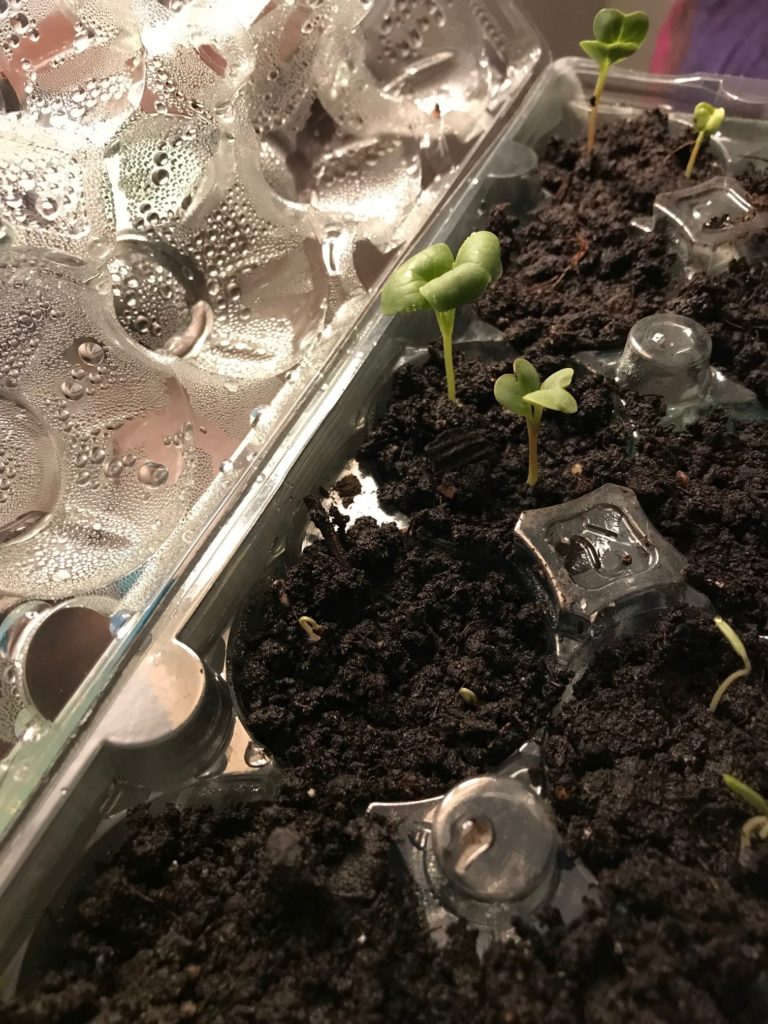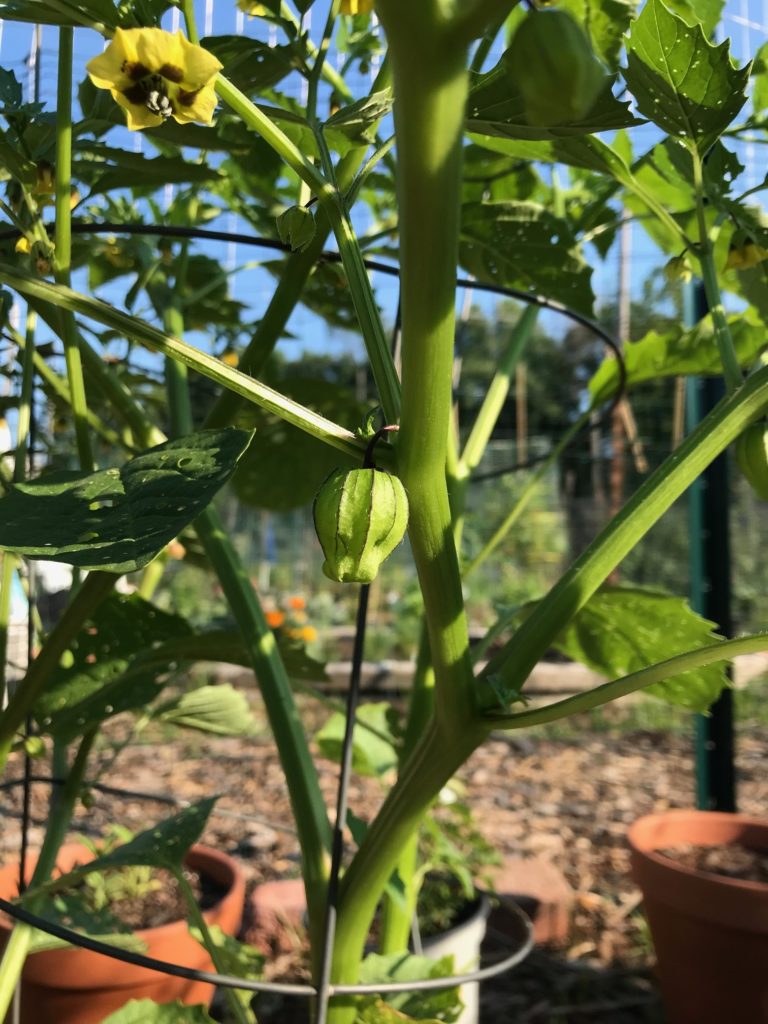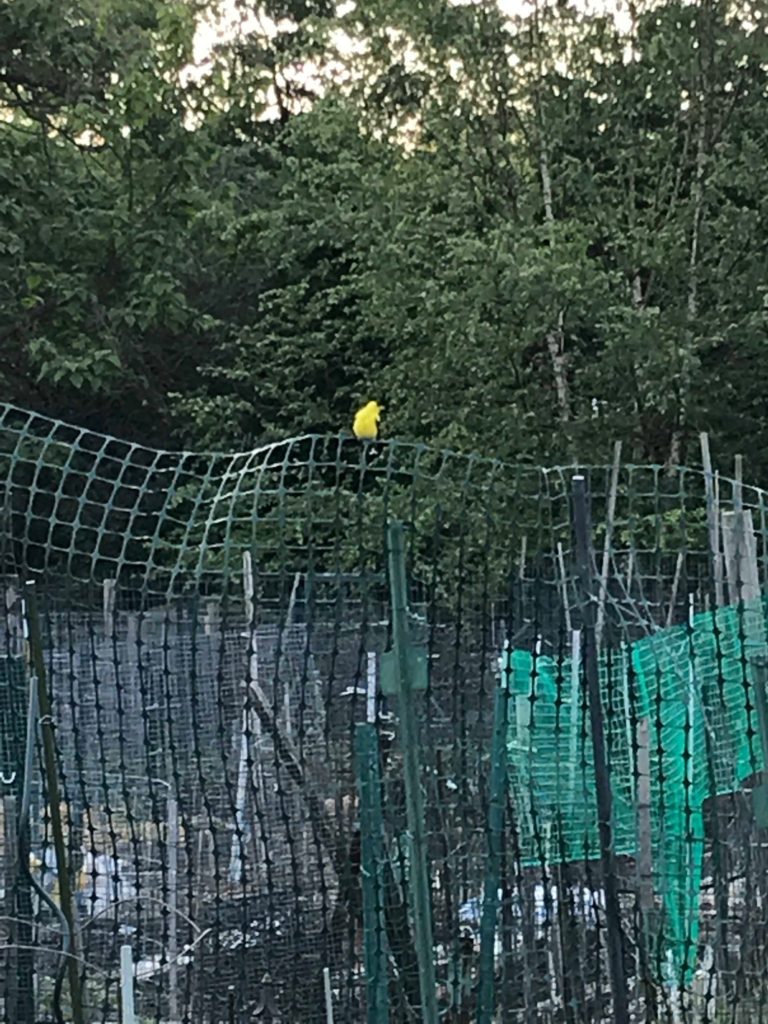And that’s a wrap, literally. On the last Saturday of November, a few of us gardeners worked to finish preparing our plots for the winter. Some were discussing if it was too late to plant garlic. Others finished pulling up plants, raking out the soil, and laying down dried leaves, newspaper, and mulch as ground cover. Joe and I went the lazier route and covered our plots with black tarp. A fellow neighbor scoffed at our amateur solution to killing weeds and let us know it would benefit us to spread dry leaves out between the ground and the tarp to ensure that the soil stays rich for next season. Okay, so maybe it’s not totally a wrap, but we have done enough to meet the garden police’s deadline for winter prep. We will fill in the gaps later. Or not.
This was our first summer working in the community garden. Just over two years ago, as soon as I realized we were moving into the neighborhood, both Joe and I signed up for the community garden wait list. Just as our first lease was expiring, we each received notices that we had finally secured plots on the community garden. Renewing our apartment lease was a no-brainer.
It was a rough summer, but fun if you’re down with sweating through your clothes and raking and digging through symptoms of heat exhaustion, cool with inexplicable amounts of rain turning your wood chip paths into canals and soil into shoe-sucking mud, and chill with mosquitoes chewing through your pants. That entire description is euphemistic at best. As the elements became increasingly swampy towards the end of summer, we admittedly found reasons we couldn’t make it out to our plots.
All said and some done, we plan to do this again in 2019. Here’s what we learned!
Lesson 1: Don’t dig a hole unless you are ready to fill it.
One corner of Joe’s plot was inhabited by an enormous hibiscus bush, its dry branches a disingenuous representation of its being. The fact that it came threateningly close to the six-foot height limit made it a bit of problem with the garden rules. The fact that it took up a ton of space, both above ground and below, was the main issue. That it appeared completely dead made it superfluous. He spent hours and buckets of sweat digging the bush out with a pickax, only to learn that it had been sucking up the extra water in the soil. It had been, in fact, very much alive. The first time it rained after he removed the offensive twig cluster, the space left by the excavation turned into a soppy mess. He had to build a raised bed to fully recover the now empty corner as a functioning garden.
Lesson 2: It’s fun until the mosquitoes arrive.
Wearing pants and drenching legs and pants in bug spray are futile actions when protecting oneself from DC’s type A mosquitoes. Full stop.
Lesson 3: Don’t trust the compost.
According to garden rules, we are not allowed to put food scraps in the community garden compost. Fair enough. No need to attract rats and other critters. However, many of the gardeners seem impervious to other rules, such as not throwing wiregrass and other nefarious weeds into the compost. I used the garden compost all summer and spent hours upon hours raking and sifting the tiny threads of these weeds out of my soil. I’m considering investing in raised beds and weed-free soil from the store next season.
Lesson 4: Wolf Spiders Jump and They Like to Stay Where You Found Them
When this season started, I was pretty proud of the fact that I was seeing small spiders around my plot and it wasn’t bothering me one bit. If you’ve ever met me, you know this is no small accomplishment. I can’t exaggerate my spider phobia. But then I found a pregnant wolf spider. Or she found me. We clearly had a common interest in occupying the garden. There was a lot of loud yelping and deep breathing on my part, especially when she jumped at me as I unexpectedly and repeatedly unearthed her. I can’t speak for the spider, but my guess is she was doing her own version of anxiety reduction.
Lesson 5: The Art of Nurturing the Seeds

Photo by Stacie Lee.
Joe spent months cultivating all kinds of plants from seeds in our apartment. He started peppers, eggplant, tomatoes, tomatillos, brussels sprouts, and more by making tiny seed pots out of old egg cartons. It was painstaking work, the kind of work I don’t have patience for, as I’m a controlled chaos kind of gal. Joe is slow and thoughtful and meticulous. I give him most of the credit for the successes in my garden because of his initial careful cultivation of most of my plants. I, on the other hand, threw a bunch of seeds in and saw little reward.
Lesson 6: The Tomatillos Though

Photo by Stacie Lee.
Except for the TOMATILLOS: Little beautiful paper lanterns, artful round purple and green marble fruits, and one plant that put out more tomatillos than we could give away. It was a salsa-verde-on-everything kind of summer.
Lesson 7: Rules Rules Rules
Understandably, our participation in the community garden comes with many rules. Being an avid rule follower, I feel like I spent most of my garden experience focused on creating a weed-free plot and periphery, instead of truly being able to enjoy the experience of actually learning how to grow plants. Joe had a much healthier and balanced relationship with his weeds. I do look forward to having a yard someday, with a garden I can manage by my own rules in order to truly enjoy the experience.
Lesson 8: The Beauty in the Beast
The birds are plentiful: gold finches, mocking birds, robins, great blue herons overhead…

Photo by Stacie Lee.
We get front row seats to stellar sunsets.
It was something for Joe and me to do together, yet apart as we each had our own plot. And of course, there were moments when we each stepped in for the other with our individual strengths.
Lesson 9: Say Hello to Your Neighbors
I live by this. While I’m an introvert by nature, I love learning from other people and enjoy small talk that leads to surprise conversations. When I’m feeling up for it, I talk to everyone – in elevators, in ride shares, on buses and metro, in stores. In the garden, I met wonderful plot neighbors who gave helpful tips along the way. And it was just nice to feel like we are all in it together out there, sharing similar pains and frustrations and successes. It’s fun to see what others grow and the different personalities play out in the plot designs and types of preferred plants.
Our new friend Steve told us about the miracle of growing peanuts. I will write about that experience next season.

Did you write about the miracle of growing peanuts? I look forward to reading it.
Great idea, Kai. Thanks for the prompt, will work on this soon.